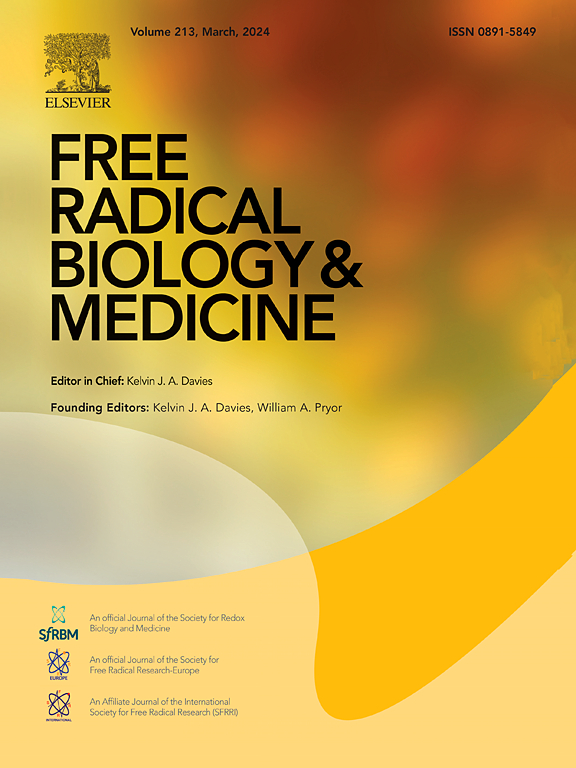达格列净通过erα -介导的脂质代谢减轻糖尿病诱导的足细胞脂毒性
IF 7.1
2区 生物学
Q1 BIOCHEMISTRY & MOLECULAR BIOLOGY
引用次数: 0
摘要
糖尿病肾病(DKD)是糖尿病的主要并发症,以足细胞损伤和脂质积累为特征,导致高发病率和死亡率。目前的治疗主要是缓解症状,强调需要靶向治疗来解决DKD进展的潜在机制。本研究探讨了选择性钠-葡萄糖共转运蛋白2 (SGLT2)抑制剂dapagliflozin (DAPA)对足细胞脂毒性的保护作用及其在雌激素相关受体α (ERRα)-酰基辅酶a氧化酶1 (ACOX1)轴中的调节作用。通过db/db小鼠和链脲佐菌素诱导的DKD模型,我们发现DAPA可以显著降低尿白蛋白与肌酐比率(ACR),并通过减轻肾小球肥大、系膜基质扩张和足细胞足突淡化来改善肾脏病理。经油红O和BODIPY染色证实,DAPA还能降低肾小球中甘油三酯和游离脂肪酸的积累。在机制上,DAPA上调ERRα和ACOX1在足细胞中的表达,增强脂肪酸氧化(FAO)并减轻脂质毒性。ERRα的缺失加剧了脂质诱导的足细胞损伤,而ERRα过表达则具有保护作用。这些发现强调了DAPA通过调节ERRα- acox1轴的肾保护作用,表明靶向ERRα可能是一种有希望的治疗DKD的策略。本文章由计算机程序翻译,如有差异,请以英文原文为准。

Dapagliflozin attenuates diabetes-induced podocyte lipotoxicity via ERRα-Mediated lipid metabolism
Diabetic kidney disease (DKD) is a major complication of diabetes mellitus, characterized by podocyte injury and lipid accumulation, which contribute to high morbidity and mortality. Current treatments primarily alleviate symptoms, underscoring the need for targeted therapies to address the underlying mechanisms of DKD progression. This study explores the protective effects of dapagliflozin (DAPA), a selective sodium-glucose cotransporter 2 (SGLT2) inhibitor, on podocyte lipotoxicity and its regulatory role in the estrogen-related receptor alpha (ERRα)-acyl-CoA oxidase 1 (ACOX1) axis. Using db/db mice and streptozotocin-induced DKD models, we demonstrate that DAPA significantly reduces the urinary albumin-to-creatinine ratio (ACR) and improves renal pathology by alleviating glomerular hypertrophy, mesangial matrix expansion, and podocyte foot process effacement. DAPA also decreases triglyceride and free fatty acid accumulation in glomeruli, as evidenced by Oil Red O and BODIPY staining. Mechanistically, DAPA upregulates ERRα and ACOX1 expression in podocytes, enhancing fatty acid oxidation (FAO) and mitigating lipidtoxicity. Loss of ERRα exacerbates lipid-induced podocyte injury, while ERRα overexpression confers protective effects. These findings highlight DAPA’s renoprotective effects via modulation of the ERRα-ACOX1 axis, suggesting that targeting ERRα could be a promising therapeutic strategy for DKD.
求助全文
通过发布文献求助,成功后即可免费获取论文全文。
去求助
来源期刊

Free Radical Biology and Medicine
医学-内分泌学与代谢
CiteScore
14.00
自引率
4.10%
发文量
850
审稿时长
22 days
期刊介绍:
Free Radical Biology and Medicine is a leading journal in the field of redox biology, which is the study of the role of reactive oxygen species (ROS) and other oxidizing agents in biological systems. The journal serves as a premier forum for publishing innovative and groundbreaking research that explores the redox biology of health and disease, covering a wide range of topics and disciplines. Free Radical Biology and Medicine also commissions Special Issues that highlight recent advances in both basic and clinical research, with a particular emphasis on the mechanisms underlying altered metabolism and redox signaling. These Special Issues aim to provide a focused platform for the latest research in the field, fostering collaboration and knowledge exchange among researchers and clinicians.
 求助内容:
求助内容: 应助结果提醒方式:
应助结果提醒方式:


